During the past 50 years in the automobile business, Autohaus Lancaster has gradually accumulated a collection of interesting vehicles from the past. Like many of our customers, we grow quite attached to certain cars and preserve them here for posterity and for mutual enjoyment. Some of these rarities are among the few remaining examples of their type.
You'll give away your age if you admit to seeing some of these beauties motoring down the highway. In those days reliability and durability were paramount. These cars are monuments to old-school craftsmanship and quality manufacture.
Some of the cars you see here are kept functional and fully operational by the Autohaus service staff. Some of the vehicles have been placed into long term storage and are not driven, as is evidenced by their exceptionally low mileage. Some of these cars were shipped to Autohaus as brand new cars and some were acquired as trade in vehicles. In reality I cannot profess to declaring a favorite as all of these cars have an interesting history and all of them are admired.
I hope that you enjoy looking at these cars and reading their descriptions. The collection is open to the public free of charge during normal store hours. I respectfully ask only that parents carefully watch their children (I have six kids, I know all about accidents) and I ask that you please refrain from crossing the ropes or touching the vehicles.
The descendants of these historic cars are upstairs, awaiting new owners to help build the memories of the future. Enjoy the road and drive safely.
I thank you for taking the time to enjoy our collection.
Tom Wanner,
General Manager


 The Speedster was introduced in late 1954 after Max Hoffman, the sole US importer of Porsches, advised the Porsche company that a lower-cost, open-top version would sell well in the American market. With its low, raked windshield (which could be removed for weekend racing), bucket seats and minimal folding top, the Speedster was an instant hit as the design was ideal for hill-climbs and other racing venues. Speedsters were very basic, very light and were built with few available factory options. As a result they were less expensive by the standards of that day. Unfortunately many of these cars were lost due to racing related mishaps. As you admire its beautiful lines, it is easy to understand why this is easily one of the most desirable of all vintage Porsches.
The Speedster was introduced in late 1954 after Max Hoffman, the sole US importer of Porsches, advised the Porsche company that a lower-cost, open-top version would sell well in the American market. With its low, raked windshield (which could be removed for weekend racing), bucket seats and minimal folding top, the Speedster was an instant hit as the design was ideal for hill-climbs and other racing venues. Speedsters were very basic, very light and were built with few available factory options. As a result they were less expensive by the standards of that day. Unfortunately many of these cars were lost due to racing related mishaps. As you admire its beautiful lines, it is easy to understand why this is easily one of the most desirable of all vintage Porsches.
This lovely example was actually traded into Autohaus Lancaster many years ago. Our founder, Herbert Wanner, retained the car and it resided in the museum for many years. Recently, the vehicle (which was silver in color when traded in) was completely restored to its original color and interior combination. All body panels match the serial number. Mr. Dennis Frick of Europa Macchina is credited with the restoration work, and this vehicle is still driven on special occasions. This car's nickname is "Speedy."
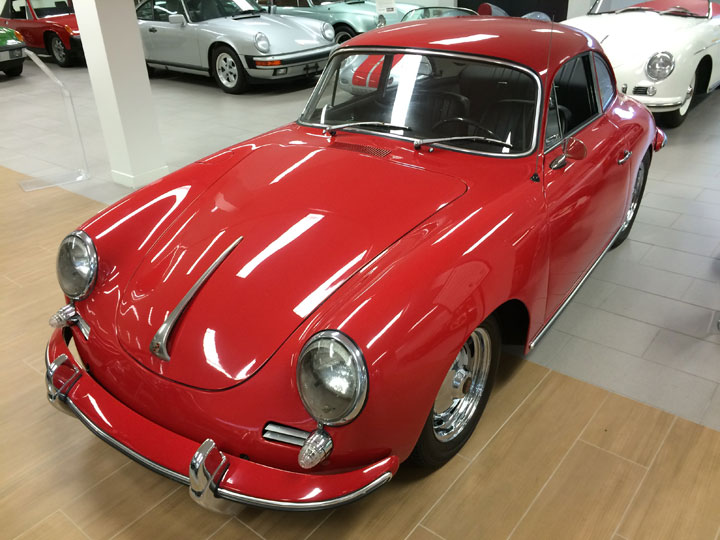
 This car is considered by many to be a "bread and butter" 356. Lacking a sunroof and "S" options, this is a fairly common model. However, 1963 was the sunset of the 356, which was replaced in '64 by the 911.
This car is considered by many to be a "bread and butter" 356. Lacking a sunroof and "S" options, this is a fairly common model. However, 1963 was the sunset of the 356, which was replaced in '64 by the 911.
Tom Wanner bought this car in 1982. It went through many stages of restoration and was finally completed in 1991. With a newly redone motor, transmission, interior, exterior (and more money than sense) it is today a good-looking "driver."

 Original mint-green paint and rare "Turbo" decal! This car was shipped to Autohaus Lancaster when brand new and Mr. Wanner used it as his demo up until 1987. The original 911 Turbos (Porsche designation 930) were built for the US market from 1974-'79. This vehicle boasts 234 horsepower at 5500 rpm with a four-speed gearbox, which may not sound like much but, combined with the car's light weight and agility, made it a world-beater in its day. Modern 911s have much-improved suspensions as well, because these early models were famous for teaching the inexperienced a lesson: in a rear-engine car, lifting off the throttle in a turn, let alone hitting the brakes, is an excellent method of swapping ends and going off backwards. It was the end of many of these fine cars.
Original mint-green paint and rare "Turbo" decal! This car was shipped to Autohaus Lancaster when brand new and Mr. Wanner used it as his demo up until 1987. The original 911 Turbos (Porsche designation 930) were built for the US market from 1974-'79. This vehicle boasts 234 horsepower at 5500 rpm with a four-speed gearbox, which may not sound like much but, combined with the car's light weight and agility, made it a world-beater in its day. Modern 911s have much-improved suspensions as well, because these early models were famous for teaching the inexperienced a lesson: in a rear-engine car, lifting off the throttle in a turn, let alone hitting the brakes, is an excellent method of swapping ends and going off backwards. It was the end of many of these fine cars.
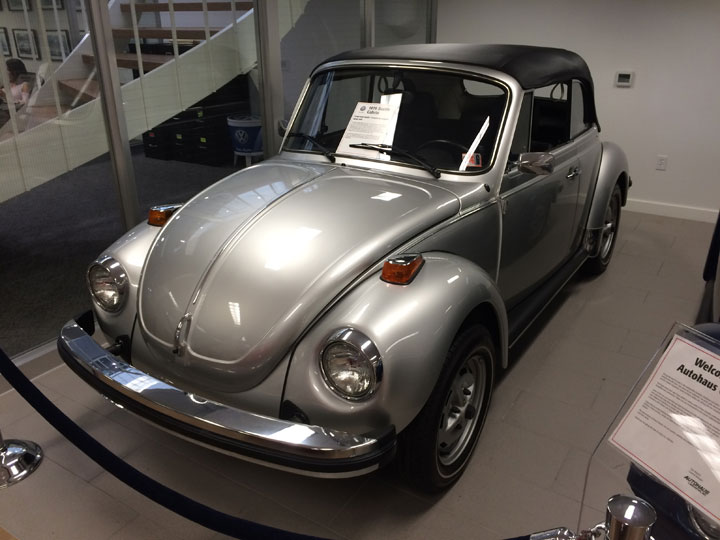
 The Beetle Cabriolet began production in 1949 by Karmann in Osnabrück. It was in 1948 when Wilhelm Karmann bought a VW Beetle limousine and converted it into a four-seated convertible. After its successful presentation to VW in Wolfsburg, series production started in 1949. After a number of stylistic and technical alterations made to the Karmann Cabriolet (corresponding to the many changes VW made to the Beetle throughout its history), the last of 331,847 cabriolets came off the conveyor belt January 10th, 1980.
The Beetle Cabriolet began production in 1949 by Karmann in Osnabrück. It was in 1948 when Wilhelm Karmann bought a VW Beetle limousine and converted it into a four-seated convertible. After its successful presentation to VW in Wolfsburg, series production started in 1949. After a number of stylistic and technical alterations made to the Karmann Cabriolet (corresponding to the many changes VW made to the Beetle throughout its history), the last of 331,847 cabriolets came off the conveyor belt January 10th, 1980.
This vehicle has never been sold to a retail customer. Mileage currently 184. This car was shipped to our store and has resided in the museum ever since. 1979 was the last official year for the Bug convertible to be imported to the United States.
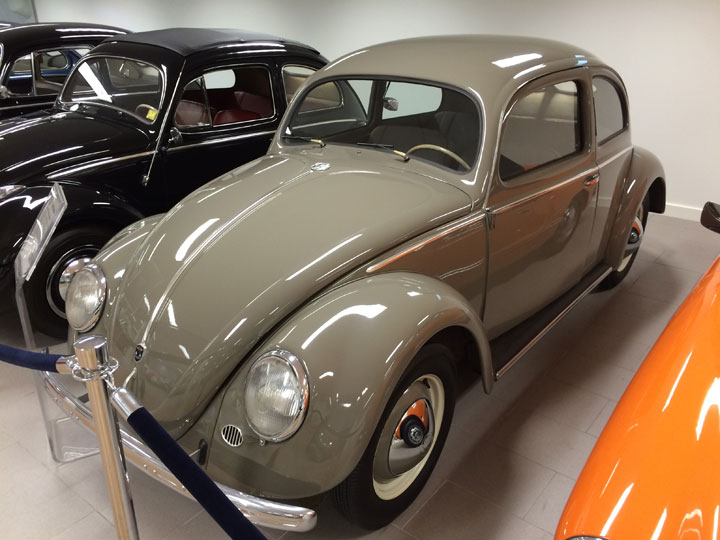
 1949 marked the first year of official importation of the Volkswagen bug to the United States. Only two bugs were imported during that first year. While this is not one of those first two bugs, it is an extremely nice example! Chances are that this was imported privately, perhaps by a military employee. It features split rear window and the semaphores (turn signals) built into the rear of the door jams. The turn signal would activate the arms which would stick out to the side and signal a turn. These were later replaced with conventional turn signals. To answer a frequently asked question, the market value of this particular bug is anyone's guess!
1949 marked the first year of official importation of the Volkswagen bug to the United States. Only two bugs were imported during that first year. While this is not one of those first two bugs, it is an extremely nice example! Chances are that this was imported privately, perhaps by a military employee. It features split rear window and the semaphores (turn signals) built into the rear of the door jams. The turn signal would activate the arms which would stick out to the side and signal a turn. These were later replaced with conventional turn signals. To answer a frequently asked question, the market value of this particular bug is anyone's guess!
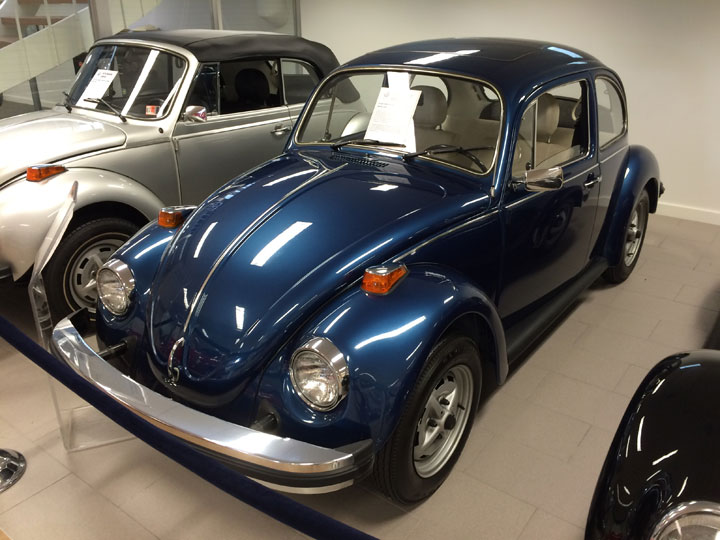
 In 1976, the hard top Super Beetle and 1300 were discontinued (though convertibles remained Super Beetles through 1979) and replaced with an 'improved' standard Beetle with 1600 cc engine, IRS rear suspension, front disc brakes, blinkers in the front bumpers, elephant's foot tail lights and rubber inserts in the bumper bars. The "Auto-stick" transmission was dropped. 1976-on Super Beetles saw no significant engineering changes, only a few cosmetic touches and new paint options. 1977 was the last official year for the Bug sedan to be imported to the United States.
In 1976, the hard top Super Beetle and 1300 were discontinued (though convertibles remained Super Beetles through 1979) and replaced with an 'improved' standard Beetle with 1600 cc engine, IRS rear suspension, front disc brakes, blinkers in the front bumpers, elephant's foot tail lights and rubber inserts in the bumper bars. The "Auto-stick" transmission was dropped. 1976-on Super Beetles saw no significant engineering changes, only a few cosmetic touches and new paint options. 1977 was the last official year for the Bug sedan to be imported to the United States.
This example, in Bahama Blue Metallic with White vinyl, is museum quality and completely original. It has never been sold to a retail customer and has only 324 miles on the odometer. The sunroof on this car is a particularly desirable option. This car, shipped to our store, was our last Beetle Sedan and has resided in the museum ever since.

 The Volkswagen Type 181 "Kurierwagen", popularly known in the United Kingdom as the Trekker, in the United States as the Thing, and in Mexico as the Safari, was a small military vehicle produced by Volkswagen from 1969 to 1983, although civilian sales stopped in 1980. It was based in part on Volkswagen's Type 1 (Beetle), and was a continuation and improvement over the Kübelwagen, which had been used by the German military during World War II. The name Kübelwagen is an abbreviation of Kübelsitzwagen, meaning "bucket-seat car."
The Volkswagen Type 181 "Kurierwagen", popularly known in the United Kingdom as the Trekker, in the United States as the Thing, and in Mexico as the Safari, was a small military vehicle produced by Volkswagen from 1969 to 1983, although civilian sales stopped in 1980. It was based in part on Volkswagen's Type 1 (Beetle), and was a continuation and improvement over the Kübelwagen, which had been used by the German military during World War II. The name Kübelwagen is an abbreviation of Kübelsitzwagen, meaning "bucket-seat car."
The Thing has become something of a cult classic, due in no small measure to its angular styling, which leaves no question as to its strictly utilitarian purpose. The doors and windows are removable without tools, and the windshield folds down, similar to a Jeep. The interior is a perfect illustration of form following function, and its painted steel door panels and split, flat bench seats look appropriately post-modern, industrial chic today.
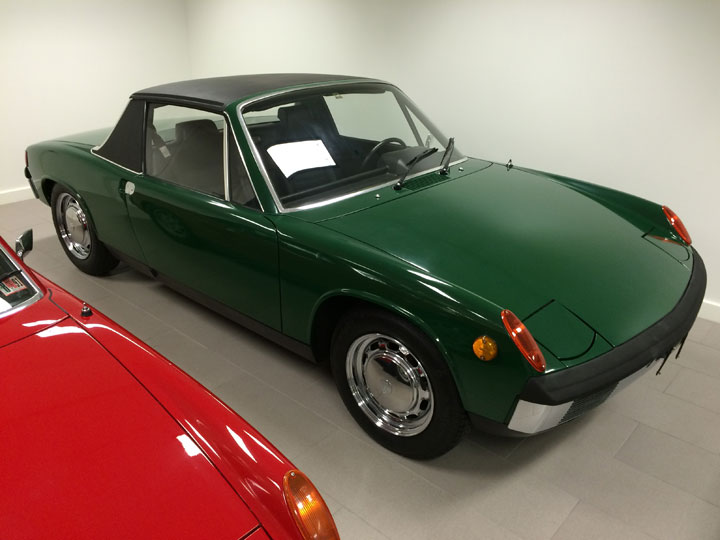
 In 1976, the hard top Back in the day, Volkswagens Audi and Porsche shared a related distribution channel, which was World Wide Volkswagen. The port also held all three brands in one location. The early Porsche 914 was not selling as well as was desired, and VW factory reps were asked to court their VW dealers and to encourage them to take a 914 out of port to help "lighten the load". A New York dealer, Mr. Donaldson of Donaldson's Volkswagen complied and told the factory that he would indeed take a 914, if they could "find him one of those 6 cylinder ones." This car was offered and was shipped to him and resided with that family until 2005 when Bill Donaldson, Mr. Donaldson's son, asked Tom about the car while attending a VW business meeting. Bill asked Tom what he should do with a 3000 mile example. Well, here it resides temporarily. The verbal agreement was that Tom not sell the car for three years. This vehicle is expected to set an auction record for this model at a collector car auction soon to be scheduled. Or, maybe not.
In 1976, the hard top Back in the day, Volkswagens Audi and Porsche shared a related distribution channel, which was World Wide Volkswagen. The port also held all three brands in one location. The early Porsche 914 was not selling as well as was desired, and VW factory reps were asked to court their VW dealers and to encourage them to take a 914 out of port to help "lighten the load". A New York dealer, Mr. Donaldson of Donaldson's Volkswagen complied and told the factory that he would indeed take a 914, if they could "find him one of those 6 cylinder ones." This car was offered and was shipped to him and resided with that family until 2005 when Bill Donaldson, Mr. Donaldson's son, asked Tom about the car while attending a VW business meeting. Bill asked Tom what he should do with a 3000 mile example. Well, here it resides temporarily. The verbal agreement was that Tom not sell the car for three years. This vehicle is expected to set an auction record for this model at a collector car auction soon to be scheduled. Or, maybe not.
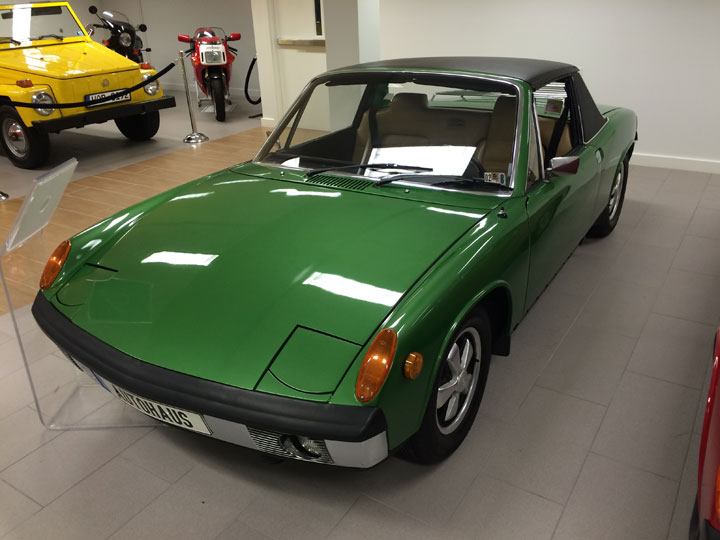
 This car was restored by Autohaus Lancaster to its current condition after being traded in on a newer Audi. The factory options make this car special. The green metallic paint is fairly rare, as is the beautiful beige interior. The car also has the "Fuchs" alloy wheels and the "Appearance Package" which includes chrome front and rear bumpers. During the restoration process, the transmission was deemed a mess. Porsche learned that we were rebuilding the car and offered us a brand new replacement unit from the parts depot. It was their last unit at the time. Small stories like these are fair example of why the dollars fly when restoring vintage cars of any brand. Even so, a single drive, and a single memory can make that investment all the more worthwhile as some memories are simply priceless. It was after one of these drives in this car that Mr. Herbert Wanner got out of the car, closed the door, looked at Tom and simply said, "hmph, it's loud and slow." A man of few words, he turned and headed for his Green Machine, the 930, his steed at that time.
This car was restored by Autohaus Lancaster to its current condition after being traded in on a newer Audi. The factory options make this car special. The green metallic paint is fairly rare, as is the beautiful beige interior. The car also has the "Fuchs" alloy wheels and the "Appearance Package" which includes chrome front and rear bumpers. During the restoration process, the transmission was deemed a mess. Porsche learned that we were rebuilding the car and offered us a brand new replacement unit from the parts depot. It was their last unit at the time. Small stories like these are fair example of why the dollars fly when restoring vintage cars of any brand. Even so, a single drive, and a single memory can make that investment all the more worthwhile as some memories are simply priceless. It was after one of these drives in this car that Mr. Herbert Wanner got out of the car, closed the door, looked at Tom and simply said, "hmph, it's loud and slow." A man of few words, he turned and headed for his Green Machine, the 930, his steed at that time.
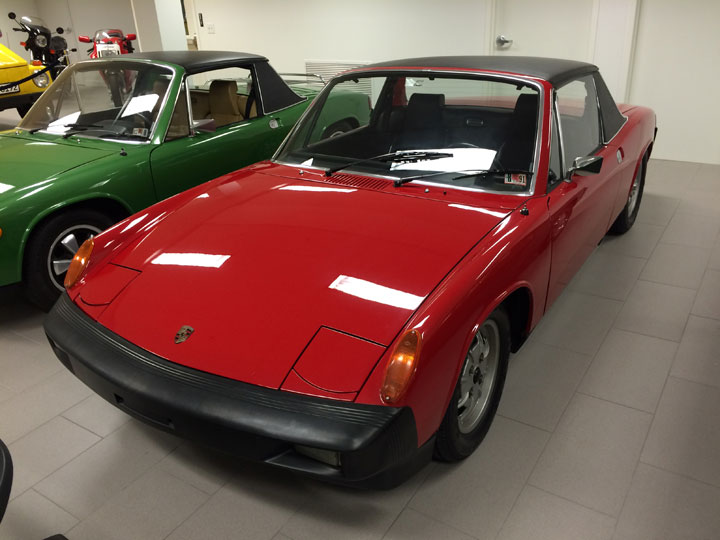
 This red car was a daily-driver 914, featuring bigger wheels and tires and a modified power plant built and installed by Tom's brother Mike, who enjoyed this car very much. Most all early Porsches exhibit substantial amounts of rust. They were cars that were driven and not "collected." They did not benefit from the zinc-coated steel that became a standard feature in 911 production effective as of 1974. The 914 line was prone to this same fate. Parties interested in buying early Porsches are urged to look, learn, look again and then decide to make the plunge as restoration work is always an expensive proposition.
This red car was a daily-driver 914, featuring bigger wheels and tires and a modified power plant built and installed by Tom's brother Mike, who enjoyed this car very much. Most all early Porsches exhibit substantial amounts of rust. They were cars that were driven and not "collected." They did not benefit from the zinc-coated steel that became a standard feature in 911 production effective as of 1974. The 914 line was prone to this same fate. Parties interested in buying early Porsches are urged to look, learn, look again and then decide to make the plunge as restoration work is always an expensive proposition.
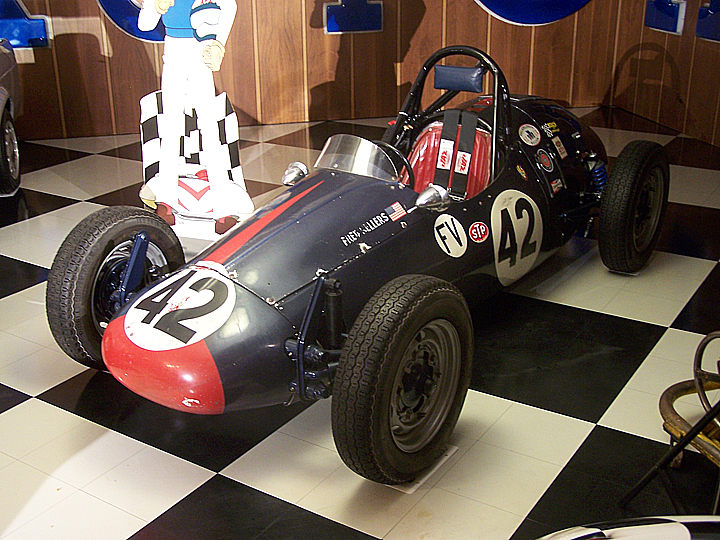
 Formula V was an affordable and highly competitive class. Powered by a modified Volkswagen Beetle engine and using various other VW components, these little race cars were a blast to drive, not to mention quite fast.
Formula V was an affordable and highly competitive class. Powered by a modified Volkswagen Beetle engine and using various other VW components, these little race cars were a blast to drive, not to mention quite fast.
Autohaus acquired this race car from a former Volkswagen of America employee, Mr. Fred Sellers. Observant individuals will recognize this particular race car as it was used in various "Volkswagen Heritage" posters wearing its number 42. Fred Sellers campaigned this car extensively and a detailed racing log remains complete with letters to the Formcar manufacturer regarding a rollover incident and the roll bar "performance" (ouch).
This race car was driven on many different tracks but extensively at Pocono and Watkins Glen. A most interesting artifact is a wooden ruler marked off in inches with pencil marks referring to 3 inches of fuel lasting 25 minutes at the Glen, or 4 inches sufficient for 25 laps at Pocono.The FV was recently refurbished. The complete mechanical workings were refurbished and freshened. Safety items were updated and the FV is now quite drivable, but we retained the vintage body shell and its wonderful patina.
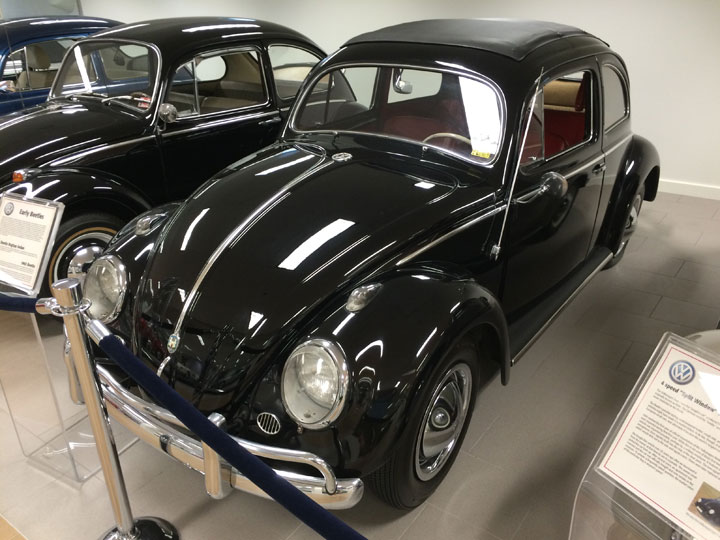
 The rag top slides backwards and folds the fabric up accordion style. This was big fun for open sky enthusiasts of the day. The specialist will note some deviations on this car versus a "correct" Beetle, nevertheless, this is a beautiful car!
The rag top slides backwards and folds the fabric up accordion style. This was big fun for open sky enthusiasts of the day. The specialist will note some deviations on this car versus a "correct" Beetle, nevertheless, this is a beautiful car!